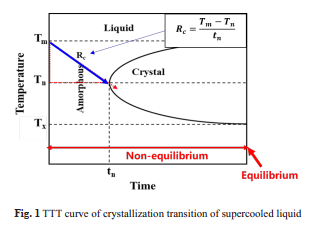Construction of non-equilibrium phase diagrams through MGI techniques
Xiaodong Xiang
Southern University of Science and Technology, No. 1088 Blvd. Xueyuan, Nanshan, Shenzhen, Guangdong
EXTENDED ABSTRACT: "Non-equilibrium phase diagram" is very important for studying the solid-state phase transition process of various alloy materials and accurately controlling the phase composition, and the TTT curve is one of the typical representatives. The quantitative description of the glass forming ability-critical cooling rate (Rc), can be obtained from the TTT curve (Figure 1):

This report will discuss how to draw non-equilibrium phase diagrams through two high-throughput preparation and characterization experimental methods and machine learning methods. Approach 1: Through continuous gradient film low-temperature diffusion experiment, the critical nucleus embryo size and nucleation work can be obtained, so that the nucleation rate and TTT curve can be obtained; Approach 2: Based on the pulsed laser heating technique, by controlling the wavelength and pulse width of the laser, the cooling rate of the target material is changed, and the precise control of the amorphous-crystalline transition is realized. The change of material resistivity during the amorphous phase transition can be characterized by the in-situ far-field optical probe method to draw the TTT curve. Through white X-Ray energy dispersive array diffraction method, the characterization sensitivity of diffraction and fluorescence signals is greatly improved, and the crystal structure (amorphous state) and composition are further verified. Approach 3: Through neural network machine learning, Tm, Tx and Rc can be accurately predicted to draw the TTT curve.

Prof. Xiao-dong Xiang is a joint Chair Professor at Department of Physics and Materials Science and Engineering in Southern University of Science and Technology. Prof. Xiang pioneered combinatorial material science at Lawrence Berkeley National Lab in 1994. His pioneer work on material gene chips was published as a cover article in <<Science>> (Xiang XD, et al., A combinatorial approach to materials discovery, Science, 268, 1738 (1995)). For his outstanding contribution to combinatorial material science, Prof. Xiang won the Discover Magazine Awards for Technological Innovation in computer hardware category in 1996 (Java Language from Sun Microsystem won the award for computer software category in the same year) and the R&D 100 Award (known as the Oscar award in industrial field) in 2000. In the interdisciplinary fields of combinatorial material science, condensed matter physics, microwave electronics, synchrotron radiation and optics, Prof. Xiang has published over 100 papers, among which, 9 papers were published in Science/Nature. Prof. Xiang has authored over 120 U.S. and international patents and more than 50 Chinese patents. Currently, his research interests include high throughput synthesis and characterization of combinatorial material chips, and their application to advanced materials.